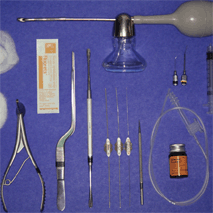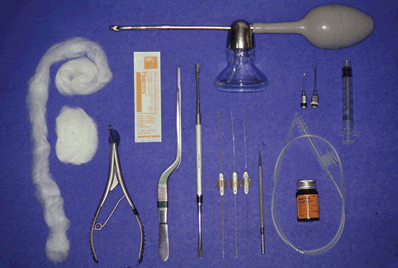Nasolacrimal Duct Probing and Intubation

Embryologically, the nasolacrimal drainage system develops from an invagination of surface ectoderm, which originates in the naso-optic fissure. Canalization occurs first in the central portion of the nasolacrimal passageways and then proceeds segmentally in both directions. Normally, the process of canalization is completed by the end of the 9-month gestational period. This system may fail to open anywhere throughout its course; however, the distal end of the nasolacrimal duct (NLD) is the most common site of obstruction. Failure of a thin membrane at the level of the valve of Hasner to perforate at birth results in blockage of tear drainage. Additionally, there are a multitude of other less common anatomic variations within this system that can cause obstruction, including impaction of the inferior turbinate or a complete bony obstruction of the NLD.
The incidence of symptomatic congenital NLD obstruction ranges from 1% to 6%; one fourth to one third are bilateral. The incidence of obstruction in premature infants is much higher. Since the ability to produce tears is present at birth, stagnation of tears within the nasolacrimal sac frequently results in tearing and mattering of the lashes within the first few weeks of life.
PREOPERATIVE EVALUATION
The proper workup of a child with epiphora should begin with a careful history. It is important to establish the onset, duration, and severity of tearing, as well as a history of ocular infection or facial trauma. It is also incumbent on the ophthalmologist to rule out the more visually threatening causes for tearing, before concluding that it is related to an obstruction of the nasolacrimal system. For instance, congenital glaucoma may have tearing as the initial presenting symptom. A detailed history and examination may reveal additional symptoms and signs of glaucoma: photophobia, blepharospasm, and breaks in Descemet’s membrane, an increased diameter, or clouding of the cornea. Additionally, careful examination can help eliminate the following: entropion, ectropion, trichiasis, distichiasis, epiblepharon, punctal atresia, conjunctivitis, foreign bodies, and more rare disorders such as crocodile tears in association with Duane’s retraction syndrome.
For adequate evaluation of a tearing neonate or young child, either loupes or, in a cooperative child, a slit lamp is required. A systematic approach to the examination will aid in eliminating these additional causes of tearing. The key components of the ocular examination include determination of eyelid and lash position and documenting punctal patency, corneal clarity, and corneal diameter.
A thorough evaluation of the lacrimal drainage system in neonates and young children is often limited. Therefore, the ophthalmologist must rely primarily on the history and external examination. The modified fluorescein dye disappearance test, as described by Katowitz and Welsh (1987), however, is a simple and useful method in assessing the integrity of the outflow system. In this test, a drop of 0.5% proparacaine is first instilled into the fornix, followed by 1 to 2 drops of 2% fluorescein solution. In a patent outflow system, the fluorescein is normally cleared from the tear lake within 10 minutes. The qualitative comparison of the rate of fluorescein egress from both sides is determined by directing a slit-lamp cobalt blue light at the eyes of the patient from several feet away. This should be done in a partially darkened room. From this distance, the light should illuminate the entire face of the child and is generally nonthreatening. Since a crying child precludes proper interpretation of this test, the parent should remain with the child throughout the test. A delay in fluorescein clearance is suggestive of an outflow obstruction.
MEDICAL MANAGEMENT
There is general agreement that the best initial management of an NLD obstruction is a combination of nasolacrimal sac massage and topical antibiotics to reduce the amount of mucopurulent discharge. Massage of the nasolacrimal sac has been shown to be effective in increasing the rate of spontaneous resolution of a distal membranous NLD obstruction.
Proper massage technique involves the parent placing his or her index finger over the medial canthal tendon and applying pressure in a nasal and downward direction to increase the hydrostatic pressure within the lacrimal sac. The parents are instructed to keep their fingernails trimmed to avoid trauma to the skin and ocular tissues. Massage should be performed four times a day with 10 to 15 repetitions each time. Following the massage, topical sulfacetamide, 10% solution, is instilled four times daily.
TIMING OF INITIAL PROBING
Controversy exists about the timing of initial probing in a patient with congenital NLD obstruction. This controversy results primarily because a high percentage will spontaneously resolve with conservative medical management alone. Katowitz and Welsh (1987) reported that 54% of congenital NLD observations resolved spontaneously by 6 months and only an additional 17% resolved by 13 months. Peterson and Robb (1978) reported similar results, with 54% resolving within 6 months and only an additional 14% spontaneously resolving by 13 months. Katowitz and Welsh (1987) also reported that delaying initial probing beyond 13 months of age resulted in decreasing success as well as increasing complexity of therapy required to achieve success.
In patients with persistent symptoms of NLD obstruction, despite an optimal course of medical therapy, consideration for probing should be given. We recommend that the initial probing be performed between 6 months and 1 year of age. This will allow most patients to resolve spontaneously yet maintain the maximum response to a first probing.
LOCATION OF THE INITIAL PROBING
Additional controversy exists over whether to perform the initial probing in the office with a papoose restraint or under general anesthesia. Our individual preference is to perform probing under general anesthesia because it permits a more controlled, gentle, and complete evaluation of the nasolacrimal system. Additionally, this approach to NLD probing allows a comprehensive examination under anesthesia, as well as a controlled infracturing of the inferior turbinate.
Since there is no consensus on timing and location of probing, the parents need to be fully informed of the possibility for spontaneous resolution, balanced against the ocular discomfort for the child and inconvenience for them with continued medical management. They should also be informed of the reduced success rate if probing is performed after 13 months of age. Exceptions to the 6- to 12-month rule arise in cases of acute purulent dacryocystitis or a dacryocystocele (amniotocele). Treatment of these cases will be outlined later.
NASOLACRIMAL DUCT PROBING
Operative procedure
On arrival to the operating room, endotracheal anesthesia is delivered by the anesthesiologist and intravenous access is obtained.

Figure 23-1. The instruments needed for probing include cotton gauze, nasal speculum, bayonet forceps, Freer periosteal elevator, assorted Bowman probes, punctal dilator, clear suction catheter, 2% fluorescein dye, irrigation cannula, 3-mm syringe, nasal atomizer, and 4% cocaine solution. The nose is then sprayed with 4% cocaine solution on the involved side. With the use of a fiberoptic headlight, loupes, nasal speculum, and bayonet forceps, the nose is packed under and around the inferior turbinate with a strip of cotton gauze moistened with 4% cocaine. The solution should be squeezed out of the gauze before packing the nose to avoid toxicity. One to two percent cocaine solution can be used in very young or frail children. The anesthesiologist should be informed of the use of cocaine, and a dose of 3 mg/kg must not be exceeded.
Stay updated, free articles. Join our Telegram channel

Full access? Get Clinical Tree


